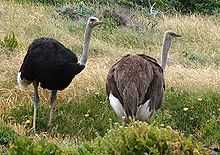Diurnality

Diurnality is a plant or animal behavior characterized by activity during the day and sleeping at night. The common adjective is "diurnal".
In animals
Animals that are not diurnal might be nocturnal (active at night) or crepuscular (active primarily during twilight, i.e., at dusk and dawn).[1] Many animal species are diurnal, including many mammals (including humans), insects, reptiles and birds. In some animals, especially insects, external patterns of the environment control the activity (exogenous rhythms, as opposed to patterns inherent in the habitat).[1] Diurnality is descriptive; it refers to an observed 24-hour pattern, as opposed to ~24-hour circadian rhythms which are self-sustaining within the organism.[2]
Some mainly nocturnal or crepuscular animals have been domesticated as pets and have changed into diurnal animals to coincide with the cycle of human life. Examples are pet dogs and cats, which are derived from the wolf and the wild cat, respectively. However, these animals may exhibit their species' original behavior when they are born feral. Other animals have been forced from their normal cycle to an alternate one as a means of avoiding predators, such as beavers becoming nocturnal creatures after extended predation by humans.
In plants
Many plants are also diurnal or nocturnal, depending on the time period when the most effective pollinators, i.e., insects, visit the plant. For example, as most angiosperm species of flower are visited by many various insects, the flower adapts its phenology to the most effective pollinators in order to ensure proper reproduction and longevity of the species. Thus, the effectiveness of relative diurnal or nocturnal species of insects affects the diurnal or nocturnal nature of the plants they pollinate, causing in some instances an adjustment of the opening and closing cycles of the plants.[3]
In Technology Operations
Services that alternate between high and low utilization in a daily cycle are described as being diurnal. For example many web sites have the most users during the day and little utilization at night, or vice versa. Operations planners can use this cycle to plan, for example, maintenance that needs to be done when there are fewer users on the web site.[4]
See also
| Look up diurnal in Wiktionary, the free dictionary. |
References
- ↑ 1.0 1.1 Gullan, P. J. and P. S. Cranston, 1994. The Insects: An Outline of Entomology. Chapman and Hall London. pg. 115.
- ↑ Klerman, Elizabeth B. (2005). "Clinical Aspects of Human Circadian Rhythms". J Biol Rhythms 20 (4): 375–386 publisher=SagePub. doi:10.1177/0748730405278353. Retrieved 2010-10-14.
- ↑ Diurnal and Nocturnal Pollination Article
- ↑ Thomas A. Limoncelli; Strata R. Chalup; Christina J. Hogan (30 March 2014). The Practice of Cloud System Administration: Designing and Operating Large Distributed Systems. Addison Wesley Professional. pp. 4–. ISBN 978-0-321-94318-7.
| ||||||||||||||||||||
